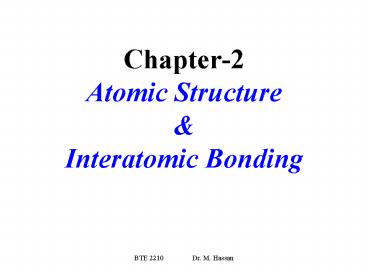Chapter2 Atomic Structure - PowerPoint PPT Presentation
1 / 30
Title:
Chapter2 Atomic Structure
Description:
Bond nature depends on electronic structure of atoms. ... small-Bismuth. Variable. large-Tungsten. small-Mercury. smallest. Comments. Nondirectional (ceramics) ... – PowerPoint PPT presentation
Number of Views:45
Avg rating:3.0/5.0
Title: Chapter2 Atomic Structure
1
Chapter-2Atomic Structure Interatomic
Bonding
2
Reading assignment
- Atomic structure, Chapter 2
- Sections 2.2, 2.3, 2.4.
- William D. Callister Jr.,
- Materials Science and Engineering.
3
Most elements Electron configuration not
stable. Why? Valence (outer) shell usually not
filled completely.
4
Bonding forces and energies
- Bond types
- Primary
- Ionic
- Covalent
- Metallic
- Secondary
- Primary bonding involves valence electrons. Bond
nature depends on electronic structure of atoms. - Why atoms bind together?
- Atoms tend to assume stable electron structures
(like inert gases).
5
Bonding forces and energies
- As two atoms approach each other, two forces
exist (each is function of separation distance - Attractive force (Depends on type of bonding).
- Repulsive force (created as atoms approach each
other, outer electron shells overlap). - At equilibrium
- The two atoms will counteract any attractive or
repulsive forces - FA FR 0
- Atomic centers become separated by r0
(equilibrium spacing).
6
Bonding energies (cont.)
- Bonding energy (Eo) Energy at equilibrium
separation, i.e., energy required to separate the
two atoms to an infinite separation (i.e., break
them apart). - Magnitude of bonding energy shape of energy vs.
interatomic separation curve depends on material
type of atomic bonding.
7
(a) The dependence of repulsive, attractive, and
net forces on interatomic separation for two
isolated atoms. (b) The dependence of
repulsive, attractive, and net potential energies
on interatomic separation for two isolated atoms.
8
The periodic table
9
- Electronegativity
- Ranges from 0.7 to 4.0,
- Large values tendency to acquire electrons.
Smaller electronegativity
Larger electronegativity
10
(No Transcript)
11
Ionic Bonding
- In compounds made of metals and nonmetals.
- (Give and take creates bonding !)
- e.g. Ceramics, NaCl
- Nondirectional bonding Bond magnitude is equal
in all directions around an ionTHUS, all
positive ions should be surrounded by negative
ions in 3D. - Ionic materials Hard, Brittle, Electrically and
thermally insulative (no free electrons).
12
Ionic bonding
13
(No Transcript)
14
(No Transcript)
15
Covalent Bonding
- Stable configuration is achieved by the sharing
of electrons between adjacent atoms (sharing is
always good !) - e.g., Nonmetallic molecules (H2, Cl2), molecules
containing dissimilar atoms (CH4), elements and
compounds composed of elements located on the
right-hand side of the periodic table (GaAs,
SiC), polymers. - For N valence electrons, an atom can share with
( 8 N ) other atoms.
16
Covalent bonding
17
(No Transcript)
18
Covalent Bonding (Cont.)
- Materials with covalent bonding
- Electrically and thermally insulative.
- Directional bonding
- Covalently-bonded materials can be Hard, High
melting temperature. Weak, low melting
temperature.
19
Partially ionic Partially covalent
- Few compounds exhibit pure ionic or pure covalent
bonding. - For a compound, the degree depends on relative
positions of atoms in periodic table (i.e,
electronegativity). - Close elements bond covalently. Far elements
bond ionically. (Distant entities need to
sacrifice to get bonded !)
20
(No Transcript)
21
Metallic bonding
- Electron cloud bind atoms. They shield
positively charge ion cores from mutually
repulsive electrostatic forces (Mediating
differences create bonding !). - e.g., all metals
- Nondirectional bond.
- Weak or strong
- Good conductors for electricity and heat (free
electrons).
22
(No Transcript)
23
Secondary bonding (Van der Waal)
- Exists between all atoms or molecules
- Electric dipole exists whenever there is some
separation of positive and negative portions of
an atom or molecule. - Evident for inert gases molecules covalently
bonded. - Arises from atomic or molecular dipoles.
- Special case Hydrogen bonding.
24
Secondary bonding
Arises from interaction between dipoles
Fluctuating dipoles
Permanent dipoles-molecule induced
-general case
-ex liquid HCl
-ex polymer
25
SUMMARY BONDING
26
(No Transcript)
27
Properties related to bonding TM
Bond length, r
Melting Temperature, Tm
Bond energy, Eo
Tm is larger if Eo is larger.
28
Properties related to bonding E
Elastic modulus, E
E curvature at ro
E is larger if Eo is larger.
29
Properties related to bonding a
Coefficient of thermal expansion, a
a symmetry at ro
a is larger if Eo is smaller.
30
SUMMARY PRIMARY BONDS
Ceramics
Large bond energy large Tm large E small a
(Ionic covalent bonding)
Metals
Variable bond energy moderate Tm moderate
E moderate a
(Metallic bonding)
Polymers
Directional Properties Secondary bonding
dominates small T small E large a
(Covalent Secondary)

